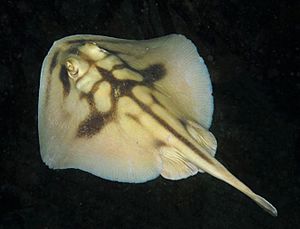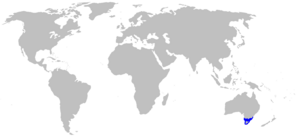Crossback stingaree facts for kids
Quick facts for kids Crossback stingaree |
|
|---|---|
 |
|
| Conservation status | |
| Scientific classification | |
| Kingdom: | |
| Phylum: | |
| Class: | |
| Subclass: | |
| Order: | |
| Family: |
Urolophidae
|
| Genus: |
Urolophus
|
| Species: |
U. cruciatus
|
| Binomial name | |
| Urolophus cruciatus (Lacépède, 1804)
|
|
 |
|
| Range of the crossback stingaree | |
| Synonyms | |
|
Raja cruciata Lacepède, 1804 |
|
The crossback stingaree (Urolophus cruciatus), also called the banded stingaree, is a type of stingray. It lives only in southeastern Australia, mostly near Victoria and Tasmania. You can also find it in small numbers off New South Wales and South Australia.
This ray lives on the ocean floor. It usually prefers sandy and rocky areas deeper than 100 meters (330 feet) off Victoria. But off Tasmania, it lives in muddy, shallow bays and estuaries. The crossback stingaree gets its name from the cool dark pattern on its back. It has a stripe down the middle with three bars crossing it.
It has an oval-shaped body with a blunt snout. Its tail is short and has a deep, leaf-shaped fin at the end. Young rays might have a small fin just before their stinging tail spine. This stingaree can grow up to 50 centimeters (20 inches) long.
During the day, the crossback stingaree is usually quiet. It often buries itself partly or fully in the sand on the seabed. It eats meat, hunting for crustaceans, worms, and other small creatures. Young stingarees eat smaller crustaceans like isopods and shrimps.
Female crossback stingarees give birth to live young. They can have up to four babies every two years. The babies grow inside the mother for at least six months. This stingaree is closely related to the yellowback stingaree. Its venomous sting can hurt humans. This common species is not often caught by fishermen. Because of this, its population is healthy. The International Union for the Conservation of Nature (IUCN) lists it as "Least Concern".
Contents
What is a Crossback Stingaree?
Naming the Crossback Stingaree
The crossback stingaree was first described in 1804. A French naturalist named Bernard Germain de Lacépède gave it the scientific name Raja cruciata. The word "cruciata" means "cross-like" in Latin. This name refers to the special cross-shaped marks on its back.
Later, in the 1830s, two German biologists, Johannes Müller and Jakob Henle, put this species into a new group called Urolophus.
Close Relatives
The crossback stingaree is very similar to the yellowback stingaree (U. sufflavus). They look alike and might even mate with each other. Scientists have studied their genes and found they are very closely related.
Where Crossback Stingarees Live
Habitat and Location
The crossback stingaree mainly lives in the coastal waters of Victoria and Tasmania. It is quite common there. You can find it as far east as Jervis Bay in New South Wales and as far west as Beachport in South Australia.
This ray lives on the bottom of the ocean. It has been found from very shallow areas near the shore down to 210 meters (690 feet) deep.
Different Homes for Different Groups
Stingarees living off Victoria prefer sandy areas and rocky reefs. They are usually found deeper than 25 meters (82 feet), most often over 100 meters (330 feet) deep.
However, stingarees off Tasmania usually live in very shallow bays and large estuaries. They prefer muddy bottoms and sometimes even go into brackish water, which is a mix of fresh and salt water.
Appearance of the Crossback Stingaree
Body Shape and Features
The crossback stingaree has a body that is a bit wider than it is long. It's shaped like an oval. Its snout is soft and blunt. Its eyes are small, and right behind them are tear-shaped openings called spiracles.
Between its nostrils, there's a flap of skin that looks like a skirt. Its mouth is small and curved, with small, oval-shaped teeth. It has five pairs of short gill slits. Its pelvic fins are small and rounded.
Tail and Sting
The tail of the crossback stingaree is fairly short, about two-thirds the length of its body. It's flat and oval-shaped. On top of the tail, about halfway down, there's a single, sharp, stinging spine. This spine has jagged edges.
When they are very young, crossback stingarees have a small dorsal fin in front of their sting. As they get older, this fin disappears, but you might still see a small bump or scar where it used to be. At the very end of the tail is a short, deep, leaf-shaped caudal fin. The skin of this ray is smooth and does not have any rough scales.
Colors and Patterns
The crossback stingaree is usually grayish to yellowish-brown on top. It has a unique pattern of dark marks. There's a stripe running down its back, crossed by three dark bars. One bar is near its eyes, one is over its gills, and one is in the middle of its body. This pattern is clearest on stingarees from the southern parts of its range.
Some rare individuals have been seen that are dark brown or black. Their underside is off-white, sometimes a bit darker around the edges of their body. The tail fin is usually grayer than the rest of the body, and there might be some dark spots on the tail. Females generally grow larger than males.
Life and Habits
Daily Life and Diet
The crossback stingaree is usually active at night. During the day, it often rests quietly on the sea floor. It can be partly or completely hidden by sand or mud. Sometimes, these rays gather in groups, even mixing with other types of stingarees.
This ray is a hunter that eats many different small creatures. It looks for food on or buried in the ocean bottom. Off Victoria, most of its diet is made up of crustaceans, especially isopods. It also eats many worms. Sometimes, it eats other things like squid.
Young stingarees, less than 30 centimeters (12 inches) across, mainly eat smaller isopods, amphipods, and shrimps. As they get older, they start eating a wider variety of larger prey, like prawns and bigger worms.
Who Hunts the Stingaree?
The broadnose sevengill shark is known to hunt the crossback stingaree. When a crossback stingaree feels threatened, it will raise its tail above its body, like a scorpion, to warn off danger.
How They Have Babies
Like other stingrays, the crossback stingaree gives birth to live young. The developing babies grow inside the mother. When the babies use up the yolk from their eggs, the mother feeds them with a special "uterine milk."
Females have litters of 1 to 4 pups every two years. The babies grow quickly for about six months. However, the total time they spend inside the mother might be longer if the eggs rest for a while after fertilization. Off Tasmania, large estuaries like the River Derwent are important places where young stingarees are born and grow up.
Growth and Maturity
Scientists have found that crossback stingarees are born at different sizes, usually between 10 and 15 centimeters (4 to 6 inches) long. They become adults and can have their own babies when they are between 20 and 32 centimeters (8 to 13 inches) long. Females usually become adults when they are a bit larger than males.
Both male and female stingarees become adults around six years old. They can live for at least 11 years.
Stingarees and People
The Sting
The crossback stingaree has a venomous sting that can cause a lot of pain if it stings a person. If the jagged tip of the sting breaks off in the wound, it might need surgery to remove it. The ray's tail is very flexible, so it can sting if any part of its body is touched.
In the past, fishermen would sometimes kill these rays by piercing their heads to remove them from nets, because of the danger of their sting.
Conservation Status
The International Union for Conservation of Nature (IUCN) has listed the crossback stingaree as "Least Concern". This means its population is not currently at risk. Most of these rays live in areas like the Bass Strait and off western Tasmania, where there isn't much fishing activity that would harm them.
While some are caught by accident in fishing nets off New South Wales, this only affects a small part of their total population. When caught, these rays often don't survive and may lose their unborn young. However, because most of the species lives in safer areas, its overall population remains strong.
Images for kids






